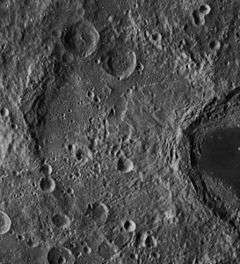
Fermi (crater)
Fermi is a large lunar crater of the category named a walled plain. It lies on the far side of the Moon and can not be viewed from the Earth. Thus this feature must be viewed from an orbiting spacecraft.
The most notable aspect of Fermi is that the large and prominent crater Tsiolkovskiy intrudes into its southeastern rim. Unlike Tsiolkovskiy, however, the interior of Fermi is not covered by dark basaltic lava, and so it is barely distinguishable from the surrounding rugged and battered terrain. If it were located on the near side of the Moon, however, this would be one of the largest visible craters, with a dimension roughly equal to the crater Humboldt, lying several hundred kilometers to the west-southwest.
This formation has been significantly eroded and damaged by subsequent impacts, and several notable craters lie across the rim and within the basin. Delporte is the most notable of these, lying across the northwest rim. Just to the east and inside the northern rim of Fermi is Litke. The smaller crater Xenophon is centered across the southern rim. In the southern half of the floor are the craters Diderot and Babakin.
Crater
Crater may refer to:
In landforms:
Other:

Crater (Aden)
Crater (/ˈkreɪtər/; Arabic: كريتر, [ˈkɾeːtəɾ]), also Kraytar, is a district of the Aden Governorate, Yemen. Its official name is Seera (Arabic: صيرة Ṣīrah). It is situated in a crater of an ancient volcano which forms the Shamsan Mountains. In 1991, the population was 70,319. As of 2003, the district had a population of 76,723 people.
In the closing days of British rule in 1967, Crater District became the focus of the Aden Emergency, sometimes called the last imperial war. After a mutiny of hundreds of soldiers in the South Arabian Federation Army on 20 June, all British forces withdrew from the Crater. The Crater was occupied by Arab fighters while British forces blocked off its two main entrances. In July, a British infantry battalion, led by Lt. Col. Colin Mitchell of the Argyll & Sutherland Highlanders, entered the Crater and managed to occupy the entire district overnight with no casualties. Nevertheless, deadly guerrilla attacks soon resumed, with the British leaving Aden by the end of November 1967, earlier than had been planned by British Prime Minister Harold Wilson and without an agreement on the succeeding governance.
Crater (Chinese astronomy)
According to traditional Chinese uranography, the modern constellation Crater is located within the southern quadrant of the sky, which is symbolized as the Vermilion Bird of the South (南方朱雀, Nán Fāng Zhū Què).
The name of the western constellation in modern Chinese is 巨爵座 (jù jué zuò), meaning "the huge wine holder constellation".
Stars
The map of Chinese constellation in constellation Crater area consists of :
See also
References
External links

Enrico Fermi
Enrico Fermi (Italian: [enˈriko ˈfermi]; 29 September 1901 – 28 November 1954) was an Italian physicist, who created the world's first nuclear reactor, the Chicago Pile-1. He has been called the "architect of the nuclear age", and the "architect of the atomic bomb". He was one of the few physicists to excel both theoretically and experimentally. Fermi held several patents related to the use of nuclear power, and was awarded the 1938 Nobel Prize in Physics for his work on induced radioactivity by neutron bombardment and the discovery of transuranic elements. He made significant contributions to the development of quantum theory, nuclear and particle physics, and statistical mechanics.
Fermi's first major contribution was to statistical mechanics. After Wolfgang Pauli announced his exclusion principle in 1925, Fermi followed with a paper in which he applied the principle to an ideal gas, employing a statistical formulation now known as Fermi–Dirac statistics. Today, particles that obey the exclusion principle are called "fermions". Later Pauli postulated the existence of an uncharged invisible particle emitted along with an electron during beta decay, to satisfy the law of conservation of energy. Fermi took up this idea, developing a model that incorporated the postulated particle, which he named the "neutrino". His theory, later referred to as Fermi's interaction and still later as weak interaction, described one of the four fundamental forces of nature. Through experiments inducing radioactivity with recently discovered neutrons, Fermi discovered that slow neutrons were more easily captured than fast ones, and developed the Fermi age equation to describe this. After bombarding thorium and uranium with slow neutrons, he concluded that he had created new elements; although he was awarded the Nobel Prize for this discovery, the new elements were subsequently revealed to be fission products.

Fermi (Turin Metro)
Fermi is a Turin Metro station, located in the Turin suburb of Collegno. Being the westerly terminus of Line 1, there is an adjacent park and ride lot with more than 300 spaces and connecting bus service from Rivoli.
Services
Fermi (disambiguation)
Enrico Fermi (1901–1954) was an Italian physicist who created the world's first nuclear reactor.
Fermi may also refer to:
Physics
Technology and engineering
Nuclear reactors
Mathematics
Podcasts:

Latest News for: fermi (crater)
Exclusive: Tiandu-2 captures and sends back latest moon images with clear lunar features
- 1
